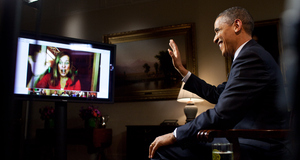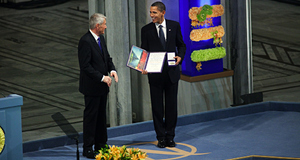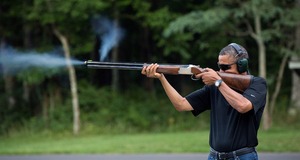The Obama PresidencyThe Myth of Obama's Post-Racial Presidency: Why Barack Obama's Election Didn't End Racial Inequality in America
By
2015, Vol. 7 No. 02 | pg. 4/4 | « ConclusionObama has been described as, “the perfect antidote to America’s corrosive racial politics.”58 From when he burst on the political scene as a junior Senator from Illinois to when he ran for president, Obama gave hope to many that our society was progressing past racial barriers. Though much has occurred during his administration, a shift away from racial distinctions has not. Racial inequality in the structures and institutions of our society were not balanced with the election of Barack Obama. Much of the structural inequality that existed prior to his administration has actually worsened with the emphasis on colorblind and race-neutral policy in economic recovery and education policies. Obama is judged based on a separate set of principles than his white predecessors because of his race. He is confined by his race and is both unable and unwilling to address the specific needs of a significant portion of his electoral support because of inaccurate claims that he unfairly acts in the favor of blacks. The Reverend Wright incident and the Gates affair clearly show the backlash received when Obama is forced to respond to racial bias in this country. The unifying message sent by his presidential campaign helped elect him to the executive office. Unfortunately, he has not been able to resolve the differences between whites and non-whites, and unify the nation. Obama is only one actor in a grand scheme of structural injustice. The racial attitudes of Americans have progressed rapidly since the Civil Rights Movement, but racial inequalities are much slower to change. The Obama administration has disappointed a large segment of voters who had hoped he would have some effect on racial orders. The existing challenges and barriers faced by racial minorities in this country disqualify our society as post-racial.The shooting of Michael Brown, an unarmed black teenager, by a white police officer in Ferguson, Missouri, has shaken the nation. The media attention on the surrounding events has placed a spotlight on the bias of the criminal justice system. The civil unrest caused by the predominantly white police force against predominantly black citizens in related protests, speaks to the present imbalance of power between the two racial groups. One significant slogan of the protestors is ‘black lives matter.’ The value of non-whites in the political process and justice system remains lower. The ills and vile injustice of race within our society did not die with the election of Obama. If anything the status of race relations in this country have gotten worse in the time that he has served. The election of Barack Obama did not signify an end to racial differences and the notion that he has is all of a lie, fallacy, or fable. Endnotes1.) ‘Black’ is used throughout this work to describe U.S.-born and naturalized citizens of African descent. The description does not take self-identification of race into account. 2.) Wilbur C. Rich, Post-Racial Society is Here: Recognition, Critics, and the Nation State, (Routledge: Taylor and Francis), 13. 3.) Rich, Post-Racial Society, 18. 4.) Rich, Post-Racial Society, 26. 5.) Charles Gallagher, “Color-Blind Privilege: The Social and Political Functions of Erasing the Color Line in Post Race America,” Jean Alt Belkhir, Race, Gender & Class Journal 10 (2003): 23, accessed November 12, 2014, http://www.jstor.org/stable/41675099. 6.) Ian H. Lopez, Dog Whistle Politics: How Coded Racial Appeals Have Reinvented Racism and Wrecked the Middle Class, (USA: Oxford University Press), 78. 7.) Lopez, “Dog Whistle,” 80. 8.) Ibid. 9.) Gallagher, “Color-Blind Study,” 25. 10.) Leanne S. Hing et al., “The Merit of Meritocracy,” Journal of Personality and Social Psychology 3 (2011): 433, accessed November 15, 2014, doi: 10.1037/a0024618. 11.) Gallagher, “Color-Blind Study,” 27. 12.) William Darity, “Beyond Broke: Why Closing the Racial Wealth Gap is a Priority for National Economic Security,” Center for Global Policy Solutions (May 2014 report): 2, accessed November 23, 2014, http://globalpolicysolutions.org/wp-content/uploads/2014/04/Beyond_Broke_FINAL.pdf. 13.) Richard Fry et al., “Wealth Gaps Rise to Record Highs Between Whites, Blacks, and Hispanics,” Pew Research Center (July 2011 Report): ch. 2, accessed November 14, 2014, http://www.pewsocialtrends.org/2011/07/26/chapter-2-household-wealth/. 14.) Sam Osoro et al., “The Roots of the Widening Racial Wealth Gap: Explaining the Black-White Economic Divide,” Institute on Assets and Social Policy (February 2013 Report): 1, accessed November 20, 2014, http://iasp.brandeis.edu/pdfs/Author/shapiro-thomas-m/racialwealthgapbrief.pdf. 15.) Ibid., 2. 16.) Ibid. 17.) Ibid. 18.) Ibid., 3. 19.) Ibid., 4. 20.) Darity, “Beyond Broke,” 10. 21.) Ibid., 11. 22.) Ibid., 13. 23.) David H Ikard et al., Nation of Cowards: Black Activism in Barack Obama’s Post-Racial America (Indiana: Indiana University Press), 108-110. 24.) Ibid., 109-111. 25.) Ibid., 57-59. 26.) David Sears et al., Obama’s Race: The 2008 Election and the Dream of a Post-Racial America (Illinois: University of Chicago Press), 32. 27.) Ibid., 56. 28.) Barack Obama, “A More Perfect Union,” Huffington Post (11/17/2008), accessed November 20, 2014, http://www.huffingtonpost.com/2008/03/18/obama-race-speech-read-th_n_92077.html. 29.) Ibid. 30.) Lopez,”Dog Whistle Politics,” 199. 31.) Lopez, “Dog Whistle,” 195. 32.) Ibid., 196. 33.) Ibid. 34.) United States Department of Justice, Fact Sheet: Racial Profiling (June 17, 2003): 1, accessed November 15, 2014, http://www.justice.gov/archive/opa/pr/2003/June/racial_profiling_fact_sheet.pdf. 35.) Barack Obama, “Blueprint for Change: Obama and Biden’s Plan for America,” (2008) accessed November 28, 2014, https://s3.amazonaws.com/s3.documentcloud.org/documents/550007/barack-obama-2008-blueprint-for-change.pdf. 36.) Robert Maranto, President Obama and Education Reform: the Personal and the Political (Palgrave Macmillan), 93. 37.) Ibid., 98. 38.) Ibid., 109. 39.) Amy Wells, “Seeing Past the ‘Colorblind’ Myth of Education Policy: Addressing Racial and Ethnic Inequality and Supporting Culturally Diverse Schools,” National Education Policy Center (2014): 10, accessed November 28, 2014, http://nepc.colorado.edu/files/pb-colorblind_0.pdf. 40.) Ikard, “Nation of Cowards,” 116. 41.) Wells, “Seeing Past,” 11. 42.) Cara Sandberg, “The Story of Parents Involved in Community Schools, “ Berkeley Law: University of California (2011): 6-7, accessed November 20, 2014, http://www.law.berkeley.edu/files/The_Story_of_Parents_Involved_Sandberg.pdf. 43.) Ibid., 7. 44.) Ibid, 11-12. 45.) Ibid, 14-20. 46.) Ibid, 30 47.) Ibid, 31 48.) Angelo Ancheta, “A Constitutional Analysis of Parents Involved in Community Schools v. Seattle School District No. 1 and Voluntary School Integration Policies,” Rutgers Race & L. Rev 297 (2008-2009) :312, accessed November 24, 2014, http://digitalcommons.law.scu.edu/cgi/viewcontent.cgi?article=1002&context=facpubs. 49.) Sandberg, “The Story,” 21. 50.) Ibid. 51.) Ibid. 52.) Ancheta, “A Constitutional Analysis,” 312-313. 53.) Wells, “Seeing Past,” 15. 54.) Thomas Santoro et al, “Fisher v. University of Texas at Austin (11-345),” LII Supreme Court Bullentin, accessed November 20, 2014, http://www.law.cornell.edu/supct/cert/11-345. 55.) Santoro, “Fisher.” 56.) Angelo Ancheta, “Brief of the American Educational Research Association et al. as Amici Curiae in Support of Respondents,” Sage Publication (2013): 191, accessed November 20, 2014, http://edr.sagepub.com/content/42/3/183. 57.) Ibid. 58.) Sears, Obama’s Race, 1. Suggested Reading from Inquiries Journal
Inquiries Journal provides undergraduate and graduate students around the world a platform for the wide dissemination of academic work over a range of core disciplines. Representing the work of students from hundreds of institutions around the globe, Inquiries Journal's large database of academic articles is completely free. Learn more | Blog | Submit Latest in Political Science |


















